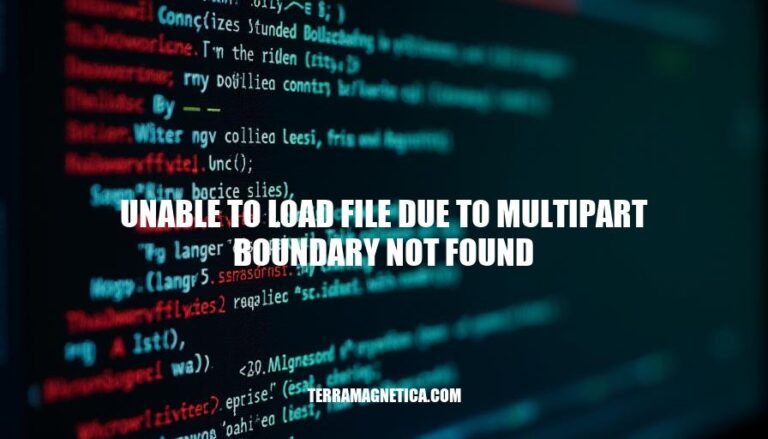


The error “unable to load file due to multipart boundary not found” often arises during file uploads. This issue occurs when the multipart boundary, a crucial part of the Content-Type header in HTTP requests, is missing or incorrectly set. This boundary helps the server distinguish between different parts of the uploaded data. Common scenarios include manually setting the Content-Type header in tools like Postman or in code, which can lead to this error if the boundary is not properly defined.
Here are the primary causes of the “unable to load file due to multipart boundary not found” error:
Incorrect Content-Type Header: Explicitly setting the Content-Type header to multipart/form-data without including the boundary parameter. The boundary is necessary for the server to parse the multipart request correctly.
Missing Boundary Definition: The boundary parameter is missing or incorrectly defined in the Content-Type header. This parameter is crucial as it separates different parts of the multipart message.
Improperly Formatted Request Body: The request body is not properly formatted, leading to the server being unable to identify the multipart boundary.
Manual Content-Type Setting: Manually setting the Content-Type header in tools like Postman or in code, which can override the automatically generated boundary parameter.
Non-Unique Boundary: The boundary string must be unique within the message. If it’s not, the server cannot correctly parse the multipart data.
The “unable to load file due to multipart boundary not found” error significantly impacts file upload functionality. This error occurs when the boundary parameter, which separates different parts of the multipart message, is missing in the Content-Type header of the HTTP request.
Ensuring the correct boundary parameter is set in the Content-Type header can prevent these issues and improve the overall user experience.
Here’s a step-by-step guide to troubleshoot and resolve the ‘unable to load file due to multipart boundary not found’ error:
Check Request Headers:
Content-Type header is set to multipart/form-data.boundary parameter is included in the Content-Type header.Remove Explicit Content-Type Header:
Content-Type header manually, remove it. Let the browser or HTTP client (like Postman) set it automatically.Verify Form Data:
Use Correct Libraries:
axios or fetch, ensure they handle the Content-Type and boundary correctly.axios:const formData = new FormData();
formData.append('file', fileInput.files[0]);
axios.post('/upload', formData, {
headers: {
'Content-Type': 'multipart/form-data'
}
});
Check Server-Side Configuration:
multipart/form-data requests.multer:const express = require('express');
const multer = require('multer');
const upload = multer({ dest: 'uploads/' });
const app = express();
app.post('/upload', upload.single('file'), (req, res) => {
res.send('File uploaded successfully');
});
app.listen(3000, () => {
console.log('Server started on port 3000');
});
Test with Different Clients:
Inspect Network Traffic:
Content-Type header and boundary.Update Dependencies:
Following these steps should help you resolve the ‘unable to load file due to multipart boundary not found’ error.
Here are the best practices to prevent the “unable to load file due to multipart boundary not found” error:
Automated Boundary Generation:
Content-Type header. This ensures the boundary parameter is correctly set.Correct Header Configurations:
Content-Type header manually, ensure it includes the boundary parameter, e.g., Content-Type: multipart/form-data; boundary=yourBoundaryString.multer for Node.js or MultipartFile for Spring.Testing and Validation:
Implementing these practices should help you avoid the multipart boundary error.
occurs when the server is unable to parse the multipart/form-data request due to an incorrect or missing boundary parameter.
To resolve this issue, it’s essential to properly configure the Content-Type header and ensure that the boundary parameter is correctly set.
Automated boundary generation by tools like Postman or browsers can help prevent this error.
Additionally, using libraries or frameworks that handle multipart form data correctly, such as multer for Node.js or MultipartFile for Spring, can also help resolve the issue.
Testing and validation using tools like Postman can further ensure that requests are correctly formatted and that the boundary is properly included.